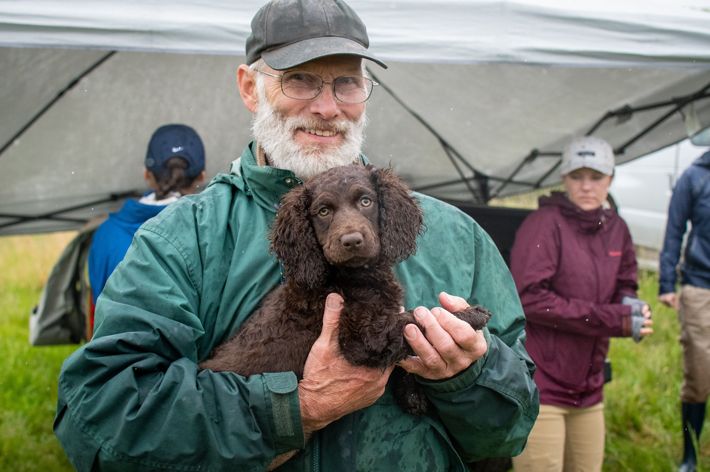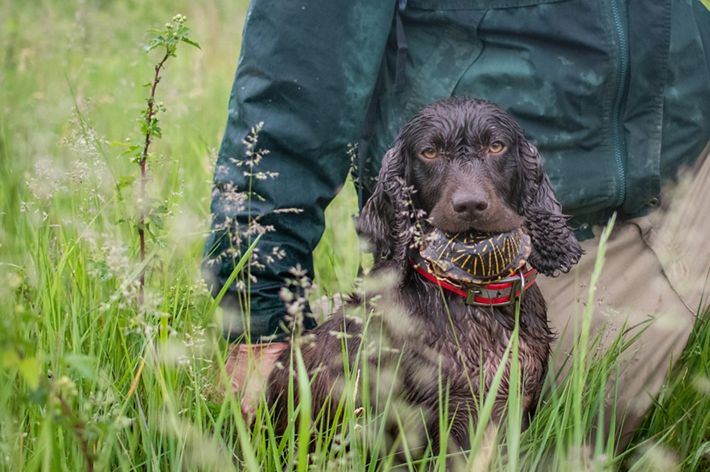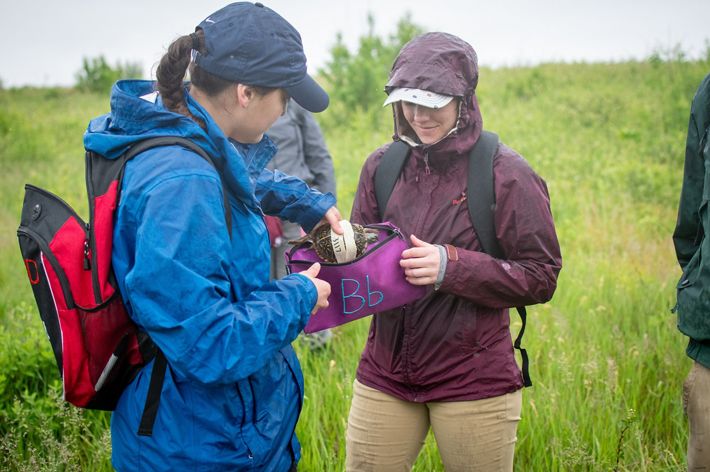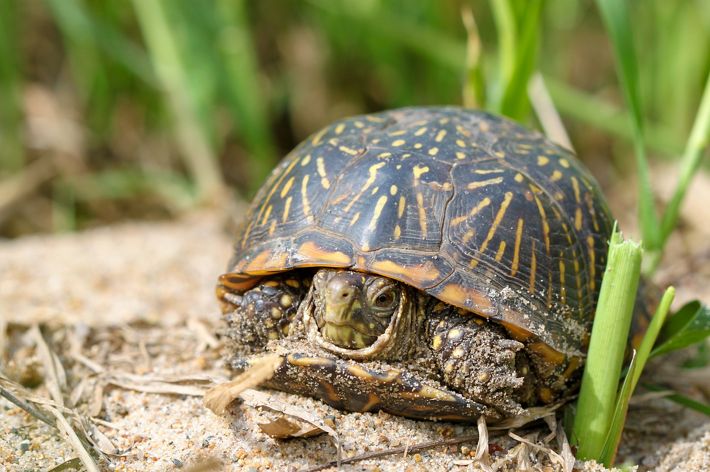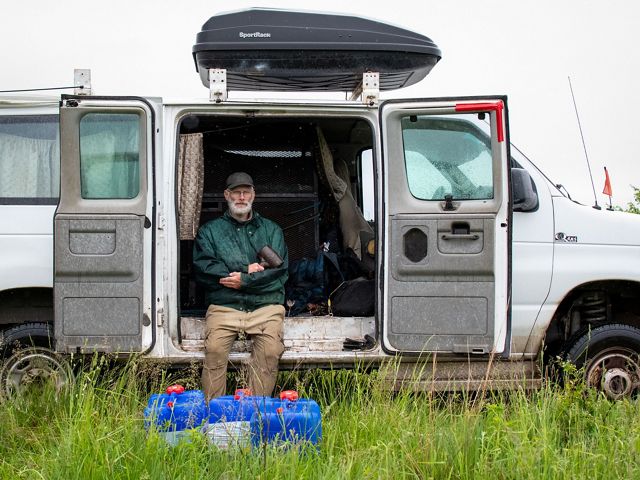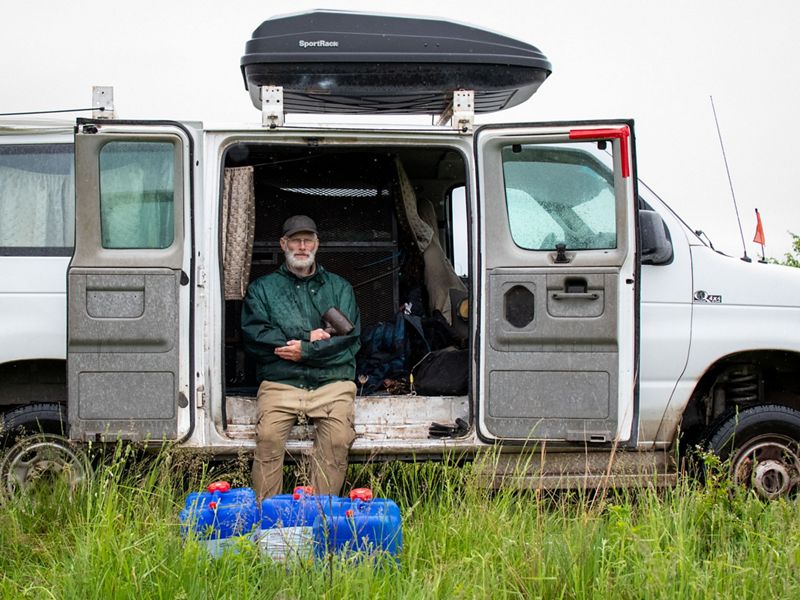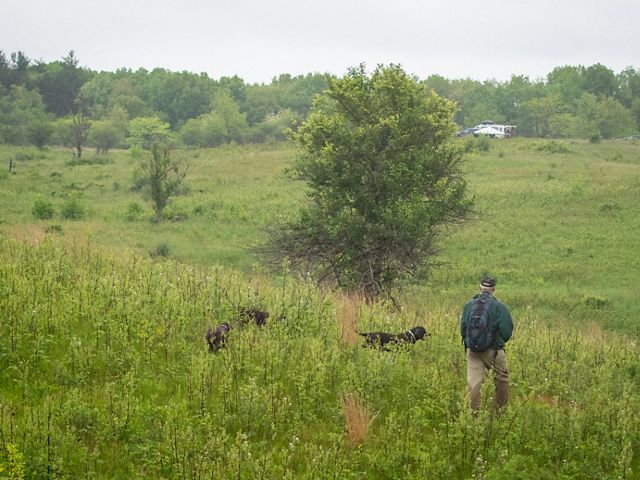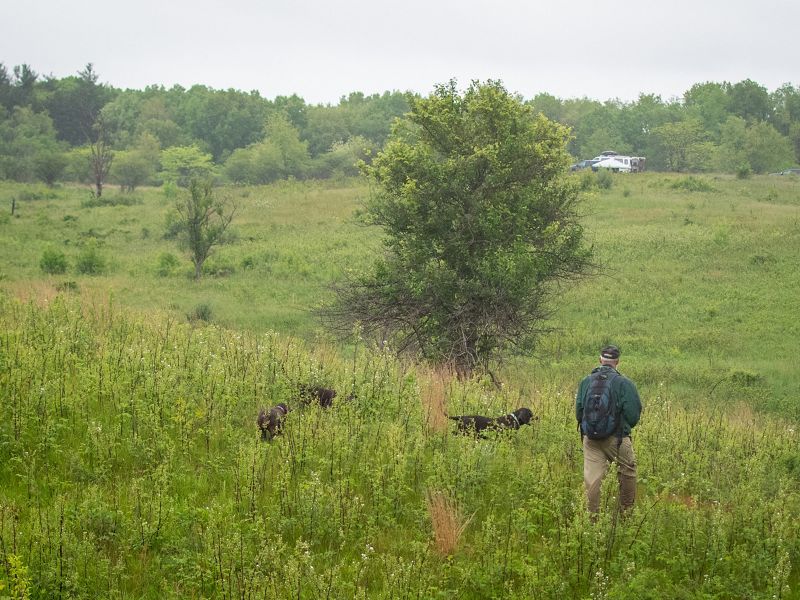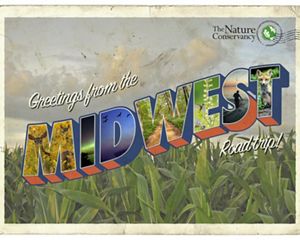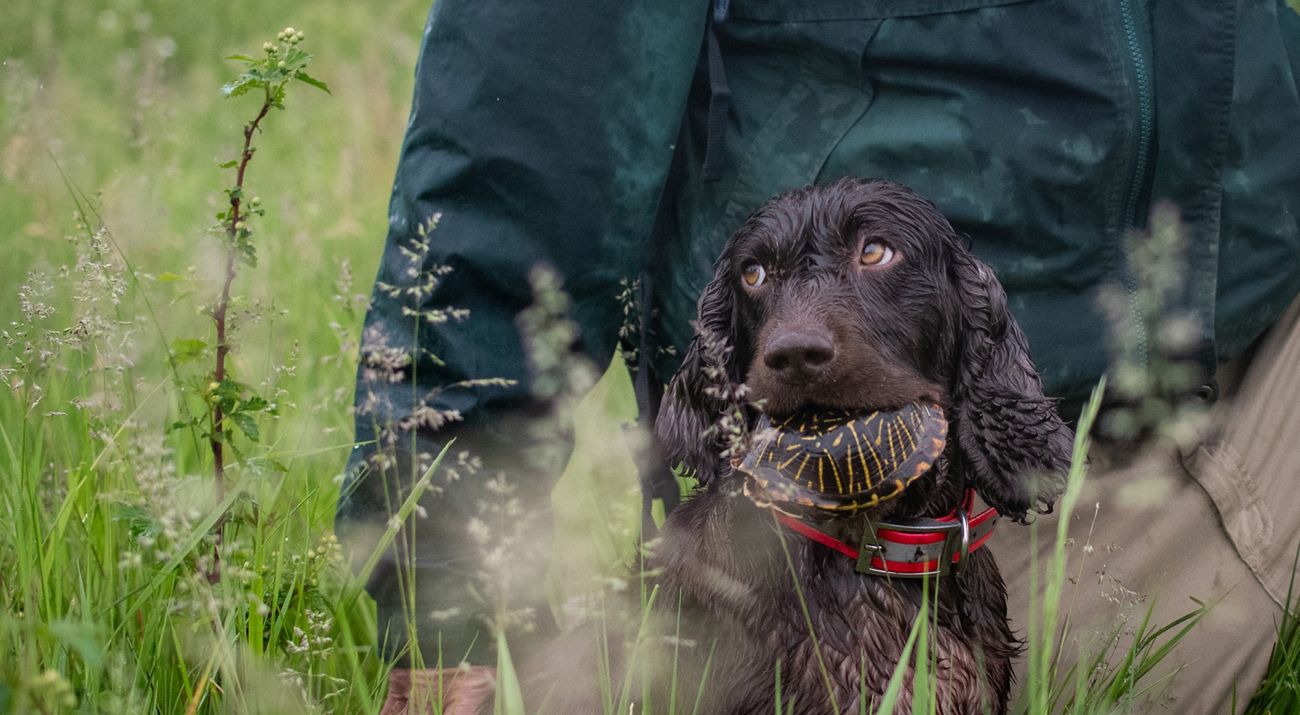
Dogs Lend Their Noses to Find Turtles for Science
Specially trained spaniels—aka turtle dogs—are helping researchers find and study elusive ornate box turtles.
Ruger, Yogi and Skeeter are unfazed by the on-again, off-again rain this chilly morning. The three Boykin spaniels have a job to do—and it’s obvious from their wagging tails and enthusiastic trotting that they love their occupation.
“Find turtle! Find turtle!” shouts the dogs’ owner and trainer John Rucker. And the three chocolate-colored dogs are off again, scampering through the prairie at TNC’s Nachusa Grasslands Preserve in Illinois, pausing every few feet to sniff a fallen branch or the roots of native grasses.
The dogs are searching for ornate box turtles (Terrapene ornata ornata), a threatened species in Illinois, for a box turtle monitoring project being conducted by the Wildlife Epidemiology Lab at the University of Illinois Urbana-Champaign (UIUC) and the Brookfield Zoo Chicago (BZC). TNC encourages scientists and researchers from around the world to use our preserves as living laboratories to study wildlife and other conservation issues. Nachusa provides a high-quality habitat for ornate box turtles—and for the scientists who study them.
UIUC veterinarian and BZC’s Director of Conservation Medicine and Sciences Dr. Matt Allender leads the investigation and warns us that the chance of finding many ornate box turtles today is low. It’s not so much the drizzling rain as the 50-some degree Fahrenheit temperature. Turtles tend to hide underground on chilly days.
Our group’s disappointment is tempered by the joy of watching the floppy-eared affectionate spaniels—as well as the beauty of the prairie in early spring. TNC’s Dr. Elizabeth Bach, ecosystem restoration scientist at Nachusa, points out native flowers, including the blue spires of wild lupine (Lupinus perennis) and the bright yellow clusters of Golden Alexanders (Zizia aurea).
Just when the expedition is about to wrap up for the morning, Rucker shouts: “Turtle! Turtle!”
Stay in the Loop.
Get local conservation stories sent right to your inbox.
John Rucker trains his dogs to carry turtles gently in their mouths.
We all rush over to see: Skeeter stands triumphant by Rucker’s side, holding an ornate box turtle tenderly in her mouth. “You see the way she just wouldn't give up, circling, circling around the spot,” says Rucker proudly of Skeeter. “She knew she could smell the turtle, but she just had to micro hunt until finally she was touching it with her snout.”
The Ornate Box Turtles
The ornate box turtle is gently removed from Skeeter’s mouth and held out for us to see. The fist-sized turtle has a lovely domed shell embellished with yellow rays like those in a child’s drawing of the sun. It has almost completely sealed itself inside its shell—a box turtle defensive trait. All members of this species have a hinged lower casing (plastron), which allow them to tightly box themselves up whenever they sense danger.
The ornate box turtle population has been declining for decades in Illinois. A primary reason is the conversion of the turtle’s home turf for agriculture and development. These terrestrial (land-based) reptiles live only in prairie, grassland and oak savanna habitats—preferably those with sandy soil, which allow them to easily burrow underground.
“You have probably seen the statistic that less than 0.01% of the original prairie remains in Illinois,” says Allender. “For ornate box turtles, this means there are not many suitable places left for them to live in the state.”

TNC’s Nachusa Grasslands offers the turtles an expansive home. At 4,000 acres, the preserve is one of the largest prairie restoration sites in the state.
“From a turtle preservation perspective, the quality of the site matters,” Bach says. “You have to keep their spaces healthy and let them do their turtle thing.”
Today, the research team and the dogs are searching for ornates in a section of Nachusa that TNC purchased about 15 years ago. The original prairie was never plowed, only grazed, which made it a good site for restoration—and for ornate box turtles, says Bach.
Keeping the original home sites of ornate box turtles intact and healthy is important to their survival, Bach stresses. The reason: ornates tend to be faithful homebodies. If the turtles are moved outside their home range, they often attempt to walk back, possibly crossing highways and other dangerous roads to get there. This tendency makes it difficult to establish new populations of ornate box turtles by transferring adults to suitable habitats, such as reconstructed prairie sites.
Bach offers this advice to anyone who comes across a turtle who appears lost: “The best thing to do is to let them go where they want. If a turtle is crossing the road, it's ok to help them, just be sure to move them to the side of the road they are attempting to reach.”
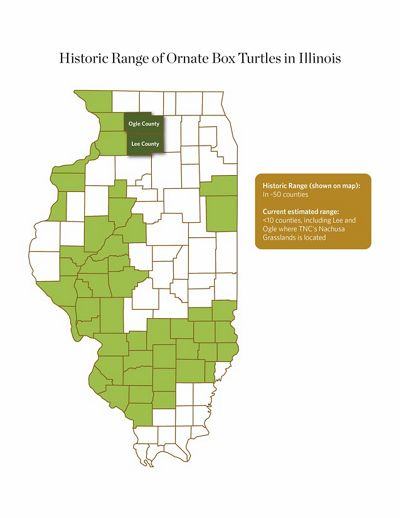
The Turtle Dogs
A dog’s sense of smell is estimated to be 10,000 to 100,000 times better than a human’s. Research has found that canines have about 30% more olfactory receptors than people do. They are also very good at detecting a specific scent when surrounded by a distracting number of odors.
It’s no wonder dogs have become essential workers in airline security, search and rescue operations and other occupations that require a sensitive nose. Dogs have also been trained for a variety of conservation tasks, such as finding endangered bumblebee nests and snuffing out the dung of leopards, bears and other wild animals to help scientists estimate numbers in these populations.
When it comes to seeking out and studying turtles, Rucker’s squad of Boykin spaniels have become critical to scientists and conservationists across North America. Rucker discovered on a hunting trip that some Boykin spaniels have an affinity for seeking out and finding turtles.
Thus began a second career for the retired English teacher and nature lover. Rucker now raises, trains and transports his dogs around the country to help find and monitor various types of turtles, including Eastern box, Blanding’s and wood turtles.
“Every single morning out with the dogs is just so special,” says Rucker. “They teach me things every day.”
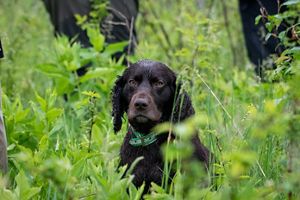
Ruger
“All business” is the descriptor given to Ruger, who is intent on his mission of finding turtles.
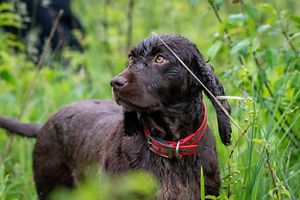
Skeeter
Confident yet eager to please, Skeeter is also the adoptive mom of the squad’s puppy, Penny.
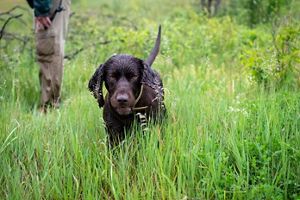
Yogi
A teddy bear, Yogi seeks out pets and hugs in between searching for turtles.
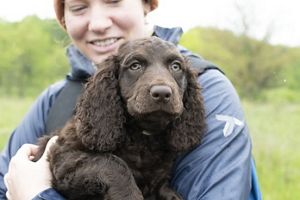
Penny
A turtle-dog-in-training, Penny brings smiles to everyone’s faces.
Boykin spaniels are known as soft-mouthed dogs, which means they are easily trained to gently pick up and carry creatures and items in their mouths without harming them. The South Carolina breed was originally bred to hunt pheasants and other birds. “I’m careful to train the dogs not to be hardmouthed or they’ll be ruined for turtle seeking,” says Rucker.
This is the ninth spring that the dogs have helped the UIUC team find ornate box turtles at Nachusa. “The dogs are tremendous tools for conservation,” says Allender. Humans, who must rely on their eyes to find turtles, usually only find about one turtle every four hours, he explains. In comparison, trained dog teams find about eight turtles per search hour, according to one study.
The Research
A flag is placed at the spot where Skeeter found the turtle so that the creature can be returned to the same location after the scientists have a chance to examine it. Then we all head up a hill to a makeshift veterinary laboratory in the flatbed of a pick-up truck.
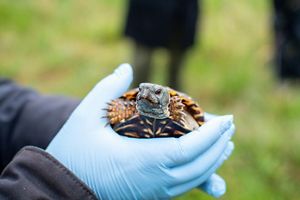
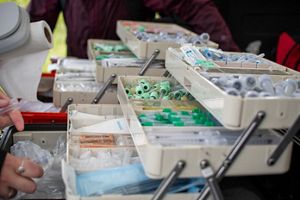


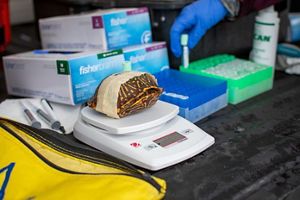

Ornate Box Turtle: Ornate Box Turtles are characterized by their iconic ruby eyes. © Philip Rudolph/TNC

Turtle Lab: The turtle research has been underway for 18 years and aims to identify health trends over time and across sites in Illinois and Tennessee. © Philip Rudolph/TNC

Portable Lab: Once the turtles are collected, the scientists retreat to a makeshift veterinary laboratory in the field to begin the check-ups. © Philip Rudolph/TNC

Analyzing Blood Samples: Researching ornate box turtles helps conservationists better understand whether or not prairie habitat is functioning as it should. © Philip Rudolph/TNC

Turtle Check-Up: Like a regular doctor visit, the turtles get weighed and measured once collected. © Philip Rudolph/TNC
The scientists take various measurements on the turtle that Skeeter found, as well as a second turtle discovered earlier in the morning. The two turtles are weighed, measured and examined. Their temperatures are taken, and their heart rates detected with a portable Doppler monitor.
Blood is also drawn to analyze later for signs of disease, ranging from anemia and inflammation to poor kidney function. A test for ranavirus—considered the Ebola of cold-blooded animals, including turtles—will also be performed. While rare, ranavirus outbreaks can quickly decimate populations.
Ornate Box Turtle Check-Up

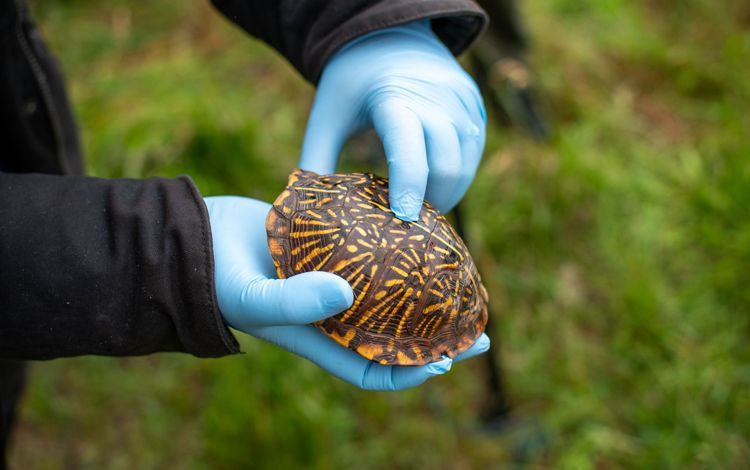
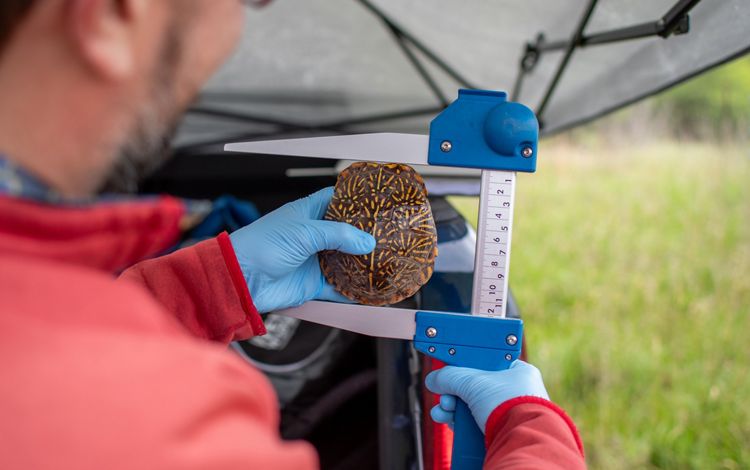
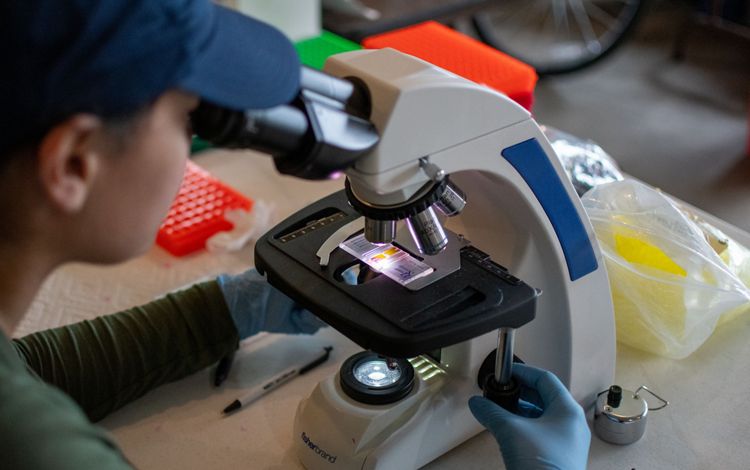
The ongoing research, which has been underway for 18 years, aims to identify health trends over time and across sites in ornate box turtles, as well as its cousin the Eastern box turtle. Data has been collected on more than 4,000 of these turtles in Illinois and Tennessee.
Because the researchers return most years to Nachusa and other locations, they often catch the same turtles more than once, which helps identify how the turtle’s health has changed over time. One of the turtles found today is a repeat capture. The researchers know from the notches in the reptile’s shell, which is a painless way to mark a turtle for ongoing study.
Both turtles found today—one female and one male—appear to be healthy based on the initial exam. The shell of one turtle has healed over puncture wounds, likely from a coyote or other predator, but the turtle was unharmed.
Quote: Dr. Matt Allender

Turtles are really good sentinels for ecosystem health. Understanding the health of these turtles helps us understand the wellness of the ecosystem that they live in.
Before returning the turtles to the prairie, Dr. Laura Adamovicz, UIUC research scientist, places tiny transmitters on them, which will allow her to find the turtles for a related study. She will be closely following 50 ornate box turtles across different sites in Illinois from May to October this year. Once a month, she will revisit each site and find the turtles she has tagged with a transmitter to repeat the health exams and tests.
“We usually only seek out the turtles once a year in spring, and we want to understand how their health status changes over the season,” says Adamovicz. “Reptiles are different to mammals because their physiology is so tied to temperature. A lot of their health variables will change based on what’s going on outside.”
Protect Nature
You can help us protect turtles, other wildlife and the lands upon which they live.
Donate NowPrairie Conservation
TNC’s Nachusa Grasslands Preserve draws scientists from around the globe to conduct research on a variety of ecological and biological issues related to prairies. “We love coming here,” says Adamovicz. “The staff at Nachusa are doing fantastic work with restoration and are very supportive of science. Plus, they happen to have a good population of ornates, which we are eager to examine. It’s the whole package.”
TNC echoes the sentiment back to all the scientists who use the preserve for research, which helps our conservationists and partners stay on top of the latest restoration know-how. “The turtle research helps us get a sense for how we can better manage the habitat here at Nachusa to improve the health and quality of life for these turtles and other wildlife,” says Bach.
A number of insights into box turtles and conservation have been uncovered by scientists. For instance, a study led by UIUC researchers—conducted at Nachusa and two other natural areas—provided invaluable information on when ornate box turtles are almost guaranteed to be underground (November 1 through April 1). This is helping TNC determine when to time prescribed fire, a key restoration tool, to protect turtles.
Another study, coauthored by researchers from the Illinois Natural History Survey, UIUC, and the Brookfield Zoo Chicago, analyzed data collected on ornate box turtles from Nachusa and another site owned by the Illinois Department of Natural Resources. The analysis suggests that ornate box turtles may be on a slow decline at both sites. One key take-away is the necessity of protecting reproductive female turtles. Healthy females lay more eggs over more seasons than unhealthy ones, ensuring the long-term stability of the population.
All in all, research shows that maintaining and restoring high-quality prairie sites like Nachusa is one of the most important ways to keep box turtle populations healthy. Another is to stay on top of the health of these creatures so that serious health problems can be detected, addressed and prevented. Toward that end, the turtle dogs are providing a vital service.
Today’s turtle outing is winding down. As we pack up and get ready to disperse, Rucker brings out the newest member of his team: Penny, a floppy-eared, energetic puppy who is currently in training to become a future turtle dog.
Penny runs from one person to another seeking hugs and attention. What better way to end a delightful and fascinating day than to play with a puppy surrounded by wildflowers and laughing people—all in the name of science.
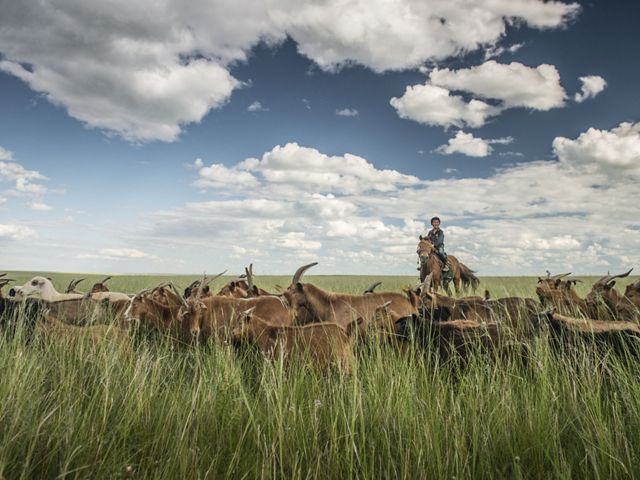
Sharing Learnings Worldwide
What we learn at Nachusa has implications beyond Illinois. Discover TNC’s grasslands conservation efforts across the U.S. in the Southern High Plains and around the world in Mongolia's amazing grasslands.

Help us Protect Turtle Habitat
Sign up to receive monthly conservation news and updates from Illinois. Get a preview of Illinois' Nature News email.
